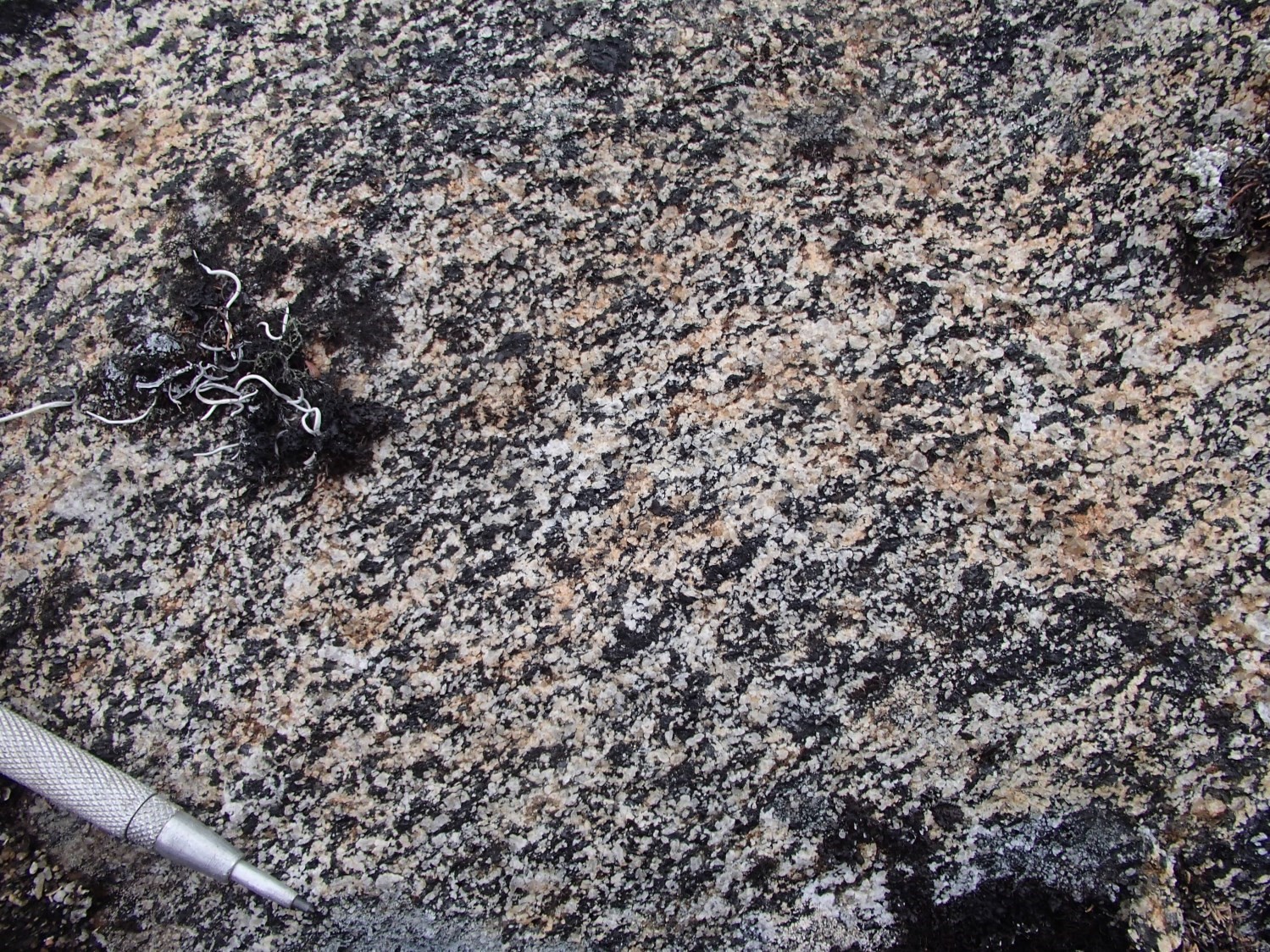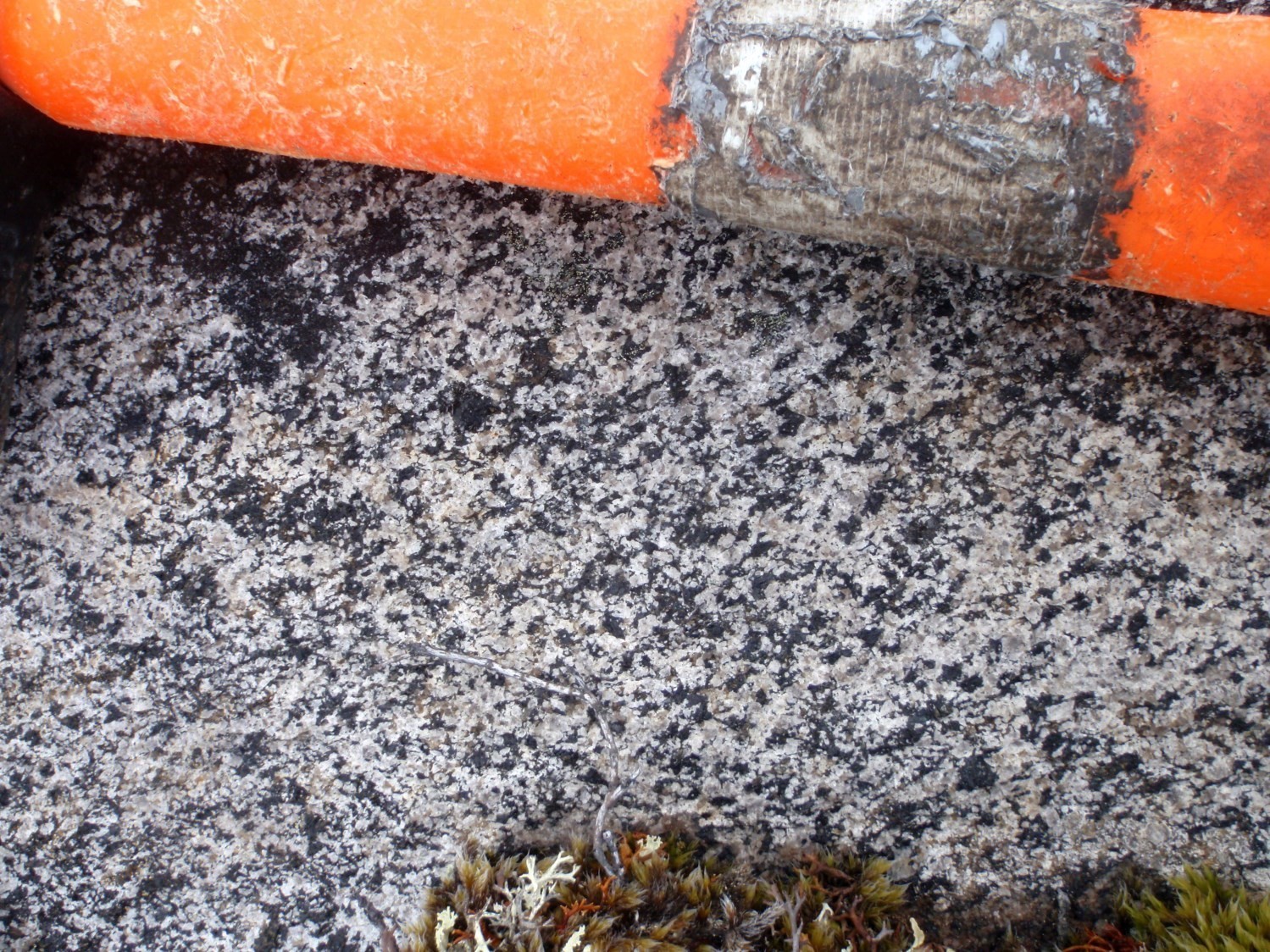
DISCLAIMER: This English version is translated from the original French. In case of any discrepancy, the French version shall prevail.
| Author(s): | Lafrance et al., 2016 |
| Age: | Paleoproterozoic |
| Stratotype: | None |
| Type area: | Brisson Lake area (NTS sheet 24A) |
| Geological province: | Churchill Province |
| Geological subdivision: | Falcoz Lithotectonic Domain |
| Lithology: | Quartz diorite |
| Category: | Lithodemic |
| Rank: | Lithodeme |
| Status: | Formal |
| Use: | Active |
None
Background
The Amarault Pluton was introduced by Lafrance et al. (2016) in the Brisson Lake area (NTS 24A) to describe a small quartz diorite pluton located in the SE part of the Falcoz Lithotectoninc Domain (Lafrance et al., 2018).
Description
On outcrops, quartz diorite of the Amarault Pluton is very homogeneous. In altered surface, it is characterized by a typical black and white mottled appearance caused by the arrangement of grains that form clusters of ferromagnesian and quartzofeldspathic minerals. Some intrusions of granular enderbite are observed, as well as rare decimetric to metric paragneiss enclaves. Quartz diorite contains 8-15% quartz, up to 7% K-feldspar and 20-30% ferromagnesian minerals consisting of green hornblende and brown biotite in roughly equal proportions. Relics of orthopyroxene variably transformed into iddingsite as well as clinopyroxene in the core of hornblende crystals were also observed in several places. The rock is massive in appearance, but may contain slight foliation defined by the alignment of ferromagnesian minerals. In thin sections, quartz diorite displays well-preserved magmatic textures and low recrystallization indicated by the presence of plagioclase subgrain clusters. There are also myrmekitic textures associated with small interstitial K-feldspar grains. Apatite, opaque minerals and zircon are present in minor amounts.
Thickness and distribution
The Amarault Pluton is associated with an elliptical magnetic trough approximately 13 km long and 5 km wide. It covers a small area (~51 km2) in the SE part of the Falcoz Lithotectonic Domain (Lafrance and Vanier, 2022). The magnetic signature of the Amarault Pluton is similar to that of paragneiss of the Lake Harbour Suite (pPhb1b). It is indeed surrounded by a paragneiss layer a few hundred meters wide.
Dating
None.
Stratigraphic Relationship(s)
The Amarault Pluton is cut by medium-grained granitic enderbite intrusions of the Inuluttalik Suite and contains orthogneiss and paragneiss enclaves of the Sukaliuk Complex and Lake Harbour Suite respectively.
Paleontology
Does not apply.
References
Publications Available Through SIGÉOM Examine
LAFRANCE, I., BANDYAYERA, D., CHARETTE, B., BILODEAU, C., DAVID, J., 2016. GÉOLOGIE DE LA RÉGION DU LAC BRISSON (SNRC 24A). MERN; RG 2015-05, 64 pages, 1 plan.
LAFRANCE, I., CHARETTE, B., VANIER, M.-A., 2018. Sud-est de la Province de Churchill, Nunavik, Québec, Canada : synthèse de la géologie. MERN; BG 2018-12
LAFRANCE, I., VANIER, M.-A., 2022. Domaine lithotectonique de Falcoz, sud-est de la Province de Churchill, Nunavik, Québec, Canada : synthèse de la géologie. MERN; BG 2022-01, 2 plans.
Suggested Citation
Ministère de l’Énergie et des Ressources naturelles (MERN). Amarault Pluton. Quebec Stratigraphic Lexicon. https://gq.mines.gouv.qc.ca/lexique-stratigraphique/province-de-churchill/pluton-amarault_en/ [accessed on Day Month Year].
Contributors
|
First publication |
Isabelle Lafrance, P.Geo., M.Sc. isabelle.lafrance@mern.gouv.qc.ca (redaction) Mehdi A. Guemache, P.Geo., Ph.D. (coordination); Claude Dion, Eng., M.Sc. (critical review and editing); Céline Dupuis, P.Geo., Ph.D. (English version); Caroline Thorn (HTML editing). |
|
Revision(s) |
Isabelle Lafrance, P.Geo., M.Sc. (redaction) Céline Dupuis, P.Geo., Ph.D. (coordination); Marc-Antoine Vanier, Eng., M.Sc. (critical review); Simon Auclair, P.Geo., M.Sc. (editing); Dominique Richard, GIT, Ph.D. (English version); André Tremblay (HTML editing). |


